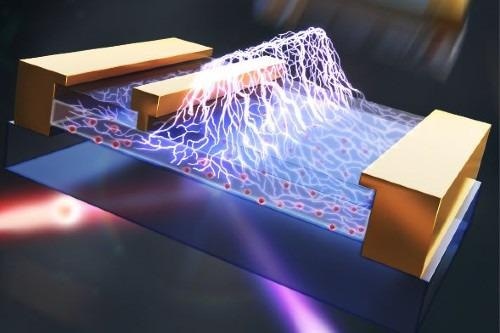Jun 22 2021
Scientists from the University of Bristol have found a new technique that will lead to better energy-saving electronics and faster communication systems.
 Quantifying electric fields in semiconductor devices: The schematic shows electric field distribution in the channel of a GaN transistor; laser beams highlight the second harmonic generation (SHG) nature of the technique. Image Credit: Yuke Cao.
Quantifying electric fields in semiconductor devices: The schematic shows electric field distribution in the channel of a GaN transistor; laser beams highlight the second harmonic generation (SHG) nature of the technique. Image Credit: Yuke Cao.
For the first time, this innovation was made by determining how to remotely quantify the electric field within a semiconductor device. A semiconductor is basically a material, like silicon, which can be utilized in electronic devices to regulate electric current.
Now, in the latest study, the researchers have described how to accurately measure this electric field, which implies that advanced power and radio frequency electronic devices can be designed that are likely to be faster, more reliable and more energy efficient. The study was recently published in the Nature Electronics journal.
The design of semiconductor devices can be trial and error, though it is often based on device simulations that subsequently provide the groundwork for producing semiconductor devices for real-life applications. While these are new and emerging semiconductor materials, the actual precision and correctness of these simulations have not been known.
Semiconductors can be made to conduct positive or negative charges and can therefore be designed to modulate and manipulate current. However, these semiconductor devices do not stop with Silicon, there are many others including Gallium Nitride (used in blue LEDs for example).
Martin Kuball, Professor, School of Physics, University of Bristol
Kuball continued, “These semiconductor devices, which for instance convert an AC current from a power line into a DC current, result in a loss of energy as waste heat – look at your laptop for example, the power brick is getting warm or even hot. If we could improve efficiency and reduce this waste heat, we will save energy.”
“One applies a voltage to an electronic device, and as a result, there is an output current used in the application. Inside this electronic device is an electric field which determines how this device works and how long it will be operational and how good its operation is. No one could actually measure this electric field, so fundamental to the device operation. One always relied on simulation which is hard to trust unless you can actually test its accuracy,” added Kuball.
To ensure the durability and excellent performance of electronic devices made from these new materials, scientists should first determine the optimal design in which electric fields do not surpass the critical value, which would lead to degradation or failure.
Experts have planned to utilize newly emerging materials, like Gallium Oxide and Gallium Nitride instead of silicon, enabling operations at higher voltages and a higher frequency, respectively, so that new circuits can be created that decrease energy loss. Published by the University of Bristol group, the study will offer an optical tool to allow the direct measurement of the electric field inside these new devices.
This will support upcoming efficient power electronics in various applications, like wind or solar turbine stations that feed into the national grid, planes, trains and electric cars. Decreased energy loss means that societies no longer have to generate as much energy in the first place.
Considering that these devices are operated at higher voltages, this also means electric fields in the devices are higher and this in turn means they can fail easier.
Martin Kuball, Professor, School of Physics, University of Bristol
Kuball added, “The new technique we have developed enables us to quantify electric fields within the devices, allowing accurate calibration of the device simulations that in turn design the electronic devices so the electric fields do not exceed critical limits and fail.”
Professor Kuball and his team have planned to work with major industrial stakeholders to use the new method to further develop their device technology. From an academic standpoint, the researchers will collaborate with partners, within the $12M US Department of Energy (DOE) ULTRA center they are associated with, to use this method to make ultra-wide bandgap device technology a reality, thus enabling energy savings of more than 10% across the world.
This development helps the UK and the world to develop energy-saving semiconductor devices, which is a step towards a carbo- neutral society.
Martin Kuball, Professor, School of Physics, University of Bristol
The new technique was devised as part of an Engineering and Physical Sciences Research Council (EPSRC) project.
Journal Reference:
Cao, Y., et al. (2021) Electric field mapping of wide-bandgap semiconductor devices at a submicrometre resolution. Nature Electronics. doi.org/10.1038/s41928-021-00599-5.